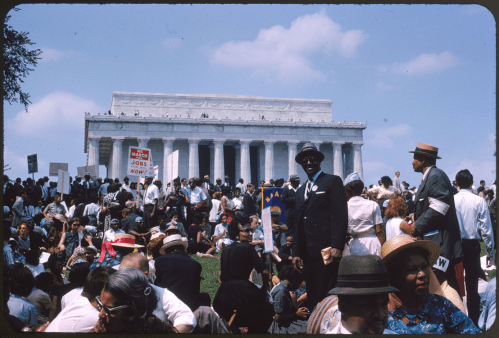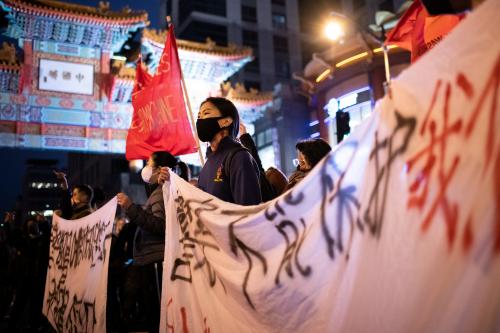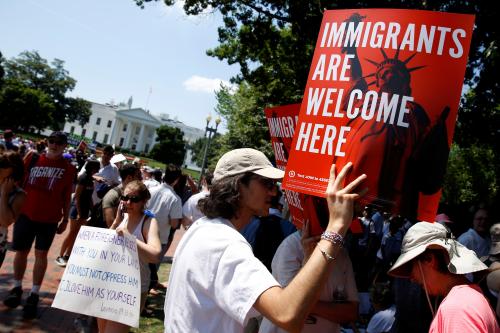If your friends and colleagues are like mine, they tend to orient their domestic travel plans around cherished ethnic restaurants. So do I. But many carry their enthusiasm a step further, seeing the extraordinary variety and quality of ethnic cuisine now available in the United States as evidence of the unalloyed benefits flowing from our racial and ethnic diversity. I call this syndrome “sushiology.”
For a more nuanced view of the profound demographic changes sweeping the United States, talk to a priest in a typical Catholic parish in southern California. The priest might, like the rest of us, wax poetic about his favorite local ethnic restaurants. But he will also note the daunting problems of, say, putting on Sunday mass for parishioners who speak English, Spanish, Vietnamese, and Tagalog. Should there be a separate mass in each language? Or should masses be multilingual, with different parts in various languages? Whichever he chooses, someone will feel neglected. And in any case, he must find priests with the needed language skills.
Language is only the most obvious problem introduced by diversity. In a small town in Iowa large numbers of new Latino immigrants create resentment among long-time Anglo parishioners when they bring little children to church and let them roam about during services. Such resentments are typically attributed to Anglo “insensitivity” or “racism.” But as the Wall Street Journal recently reported, intense animosities have flared between newly arrived Mexicans and more established Puerto Ricans and Dominicans in a predominantly Latino parish in the Bronx. No wonder the Hispanic Jesuit Alan Figueroa-Deck, writing in the liberal Catholic magazine America, criticizes the hierarchy’s “ideology of multiculturalism” and points to the remarkable success of Evangelical and Pentecostal Protestants in building ethnically homogeneous congregations among Latinos. Clearly, diversity’s beauty is in the eye of the beholder.
Does diversity work? And how well? Surprisingly, neither question gets much attention. The benefits and costs of diversity have yet to be adequately evaluated in light of specific problems or objectives. In this brief space I will move beyond the anecdotal evidence?beyond sushiology?and review some findings of social scientists who have systematically examined the consequences of racial and ethnic diversity. Not surprisingly, these findings conflict. But at the very least, they show the sushiologists’ view to be wildly optimistic. A more sober perspective is needed, one that remembers what political and social thinkers have long understood: that diversity is typically associated with dissent and conflict. Why is this downside of diversity so consistently overlooked?
Balancing Benefits and Costs
Let’s look again at ethnic restaurants. What does it mean to patronize such establishments? Analytically, it means engaging in a market exchange relationship where the negative externalities sometimes associated with immigration are minimized, ignored, or reversed. For example, a language barrier, inconvenient in other contexts, is part of the ambience diners enjoy in a restaurant. And if they don’t like the food, they can take their business elsewhere. They can also focus on those dishes that please their palates, such as chicken mole, and avoid those that do not, such as menudo, the pungent soup that Mexicans make from bovine entrails.
So visits to ethnic restaurants feature a high degree of consumer sovereignty. Indeed, the public accommodation provisions of the 1964 Civil Rights Act offer customers complete freedom of choice among eateries, while giving proprietors practically no choice about whom they may serve. Surely this is one reason why Americans enjoy ethnic restaurants so much and why diversity enthusiasts cite them so frequently. But the imbalance built into such relationships makes them atypical, a poor basis for generalizations about the costs and benefits of diversity.
What about diversity in other realms? Immigration, for instance? There the discussion, at least among social analysts, begins to take into account both costs and benefits. While sushiologists enthusiastically invoke diversity in their defense of currently high levels of immigration, economist George Borjas criticizes that same policy by noting that it lacks diversity. Pointing out that today’s influx is much more ethnically homogeneous than that a century ago, Borjas argues that greater diversity in the national-origin mix of the current immigrant stream is needed to retard the development of isolated ethnic enclaves. He concludes: “Ironically, ‘diversity pays’ in a sense that is at complete odds with what is typically implied by those who favor multiculturalism.”
Economist Edward Lazear advances a different rationale for diversity. He suggests that a more ethnically varied immigrant stream would make Americans more productive by introducing new modes of thinking and more efficient ways of delivering goods and services. In a related vein, political scientist James Scott makes a case for social diversity: “Like the diverse old-growth forest, a richly differentiated neighborhood with many kinds of shops, entertainment centers, services, housing options, and public spaces is, virtually by definition, a more resilient and durable neighborhood. Economically, the diversity of its commercial ‘bets’ (everything from funeral parlors and public services to grocery stores and bars) makes it less vulnerable to economic downturns. At the same time its diversity provides many opportunities for economic growth in upturns.”
As Scott acknowledges, he draws heavily on the work of urban analyst Jane Jacobs. And while neither Scott nor Jacobs is concerned specifically with race or ethnicity, this dimension of social diversity is clearly implicit in their analyses. More to the point, neither Scott nor Jacobs focuses narrowly on the economic benefits of diversity. Both argue that diversity sustains the informal relations on which the formal institutions of modern societies critically depend for social order.
Yet Jacobs’s insight can lead to quite different conclusions. Her work has been relied on by social scientists developing innovative approaches to law enforcement, such as community policing. And here, diversity appears less rosy. Writes Wesley Skogan: “Equitable Community Policing efforts may only be possible when there is a degree of homogeneity and consensus that does not exist in many troubled neighborhoods?. One of the greatest problems is that it is difficult to organize low-income, heterogeneous, deteriorating, high-turnover, disorderly neighborhoods. For community organizers, the American context of diversity is a fundamental part of the problems they face.”
This skepticism is echoed by criminologists Jerome Skolnick and David Bayley, who observe: “Police-community reciprocity can be achieved only where there is a genuine bonding of interests between the police and the served citizenry, on the one hand, and among definable sections of the public, on the other. That may turn out to be progressively difficult to accomplish in demographically complex urban areas, with their increasingly ethnic diversity.”
Other analysts note the deleterious impact of racial and ethnic diversity on working-class cohesion and social democratic movements. Comments political scientist Gary Freeman: “Weak labor movements are generally found in those countries that are ethnically heterogeneous. The most notable example is, of course, the United States, where racial divisions have historically vitiated the efforts of the labor movement to push for social reform. By making racially diverse societies out of previously homogeneous ones, migration has complicated social and political cleavages.”
Equally suggestive is the body of research produced by social psychologists and organizational behavioralists, some drawing on small-group research in laboratory settings, others on field analysis of natural settings. Strikingly, few of these studies focus on racial and ethnic diversity?as opposed to age, gender, or occupational diversity. One possible explanation was unexpectedly highlighted in a survey of more than 500 employees at the international headquarters of a major household goods moving firm. Survey researchers were permitted to collect data on a variety of employee characteristics?but not on ethnic background and nationality.
Diversity Brings Conflict
A consistent finding of research is that racial and ethnic diversity can generate more creative and innovative ideas?but that it is also linked with conflict, especially emotional conflict among co-workers. In a nutshell, diversity appears to produce both positive outcomes and obstacles to implementing those outcomes. To be sure, racial and ethnic diversity is not the only source of conflict in such settings. Age similarity, for instance, can foster intense competition among peer rivals, which can undermine organizational cohesion. Nevertheless, racial and ethnic diversity appears to be a salient source of dissension and conflict.
Not surprisingly, the proportions of racial and ethnic minorities affect these outcomes in complicated ways. The effect of a single minority individual on group dynamics, whether social interactions or task performance, will differ from that of several. Then, too, not all sources of racial and ethnic diversity are equivalent. There is evidence that Asians and whites work together better than blacks and whites. There is also evidence that culturally diverse groups perform better on lengthy and complex tasks than on simpler, quick-turn-around assignments.
Explanations of these dynamics vary. Again, the most obvious and mundane is language. In the dry formulation of one study of multinational military forces: “Cultural heterogeneity may contribute to the emergence of coordination and communication problems.” More sophisticated explanations rely on “social categorization theory,” which posits the familiar tendency of individuals to be drawn to those like themselves and to create in-groups and out-groups. It is precisely this dynamic that results in racial and ethnic conflict within organizations. Yet social categorization theory also suggests the possibility of creating broadly inclusive common identities and goals that would subsume racial and ethnic identities and moderate such conflicts.
Thus, while most researchers find an association between racial and ethnic diversity and conflict, they also hold out hope that the conflict can be managed and even overcome?in other words, that the benefits of diversity can be made to outweigh the costs. At the end of their careful review of 40 years of research on diversity (including racial and ethnic) in organizations, psychologists Katherine Williams and Charles O’Reilly conclude: “The preponderance of empirical evidence suggests that diversity is most likely to impede group functioning. Unless steps are taken to actively counteract these effects?by itself, diversity is more likely to have negative than positive effects on group performance? In our view, these conclusions suggest that diversity is a mixed blessing and requires careful and sustained attention to be a positive force in enhancing performance.”
Downplaying the Tensions
Needless to say, getting to where the benefits of racial and ethnic diversity outweigh the costs can be a tall order. Precisely because diversity is a mixed blessing, it is difficult to muster the careful and sustained attention needed to make it work?especially in a highly individualistic and competitive society, where the organizational or governmental capacity to sustain such focus is always in short supply. Not surprisingly, advocates, especially those concerned with “diversity management,” tend to downplay or even deny the fundamental tensions and conflicts engendered by diversity.
A case in point is University of Michigan psychologist Patricia Gurin, whose research on diversity in higher education was submitted as part of a recent, widely publicized federal suit over Michigan’s affirmative action undergraduate admission program. (As of this writing, the policy remains in place, pending final determination by a federal appeals court.) Without engaging either the methodological disputes surrounding Gurin’s research or the substantive disagreements over her support for affirmative action, I would suggest that Gurin’s work exemplifies the pervasive but little noted tendency to downplay the costs of diversity.
Gurin’s argument in favor of racial and ethnic diversity on campus draws on the work of Erik Erikson, Jean Piaget, and other developmental psychologists, who hold that the emotional and intellectual development of young adults depends critically on being confronted by discontinuities and discrepancies with their own family backgrounds. While Gurin acknowledges that Erikson was not making an explicit case for social diversity, she strenuously maintains that his arguments “provide a strong theoretical rationale for the importance of bringing students from varied backgrounds together to create a diverse and complex learning environment.”
Such insights have become conventional wisdom, especially among the middle and upper-middle classes. No surprises here. What is noteworthy about Gurin’s analysis is her effort to secure the benefits of racial and ethnic diversity without incurring the costs. To be sure, she explicitly bases her theoretical perspective on the assumption that diversity leads to conflict and that “it is discourse over conflict, not unanimity, that helps democracy thrive,” buttressing the point with references to Aristotle.
Yet when Gurin moves beyond theory to address the specific implications of diversity at universities, her celebration of diversity-induced conflict gets downplayed, even disappears. She writes: “Institutions with diverse student bodies must be attentive to creating conditions that diminish competition among groups and value the diversity that students bring to the classroom as an important part of making the most of learning that can occur in diverse classrooms.” Gurin goes on to gently chide race relations researcher Hubert Blalock for not addressing how to diminish racial conflict: “Blalock theorizes that as the number of minority individuals increases, the greater the likelihood that there will be conflict and competition with members of the majority. He does not theorize, however, how conflict can be minimized under conditions where increased diversity is inevitable. Educational institutions have the potential to minimize conflict.”
Cultivating a Taste for Conflict
Gurin is hardly alone in trying to have it both ways. Many of us avoid facing up to the full implications of diversity. Historian John Higham traces this aversion to the romanticism that underlies contemporary pluralism. Today’s celebration of diversity, he notes, began more than a century ago with writers like William James, who “depended on an unstated assumption that a natural harmony underlies the conflicts and discords of life? In an essentially friendly universe the parts can be true to their separate characters. Purposes can clash without rending.”
So, when diversity leads, as it usually does, to competition and conflict, we explain them away as the result either of irrational prejudice or of politics. The latter explanation is especially tempting, given our Lockean bent for limited government. Moreover, because of our tragic and violent racial history, in which the competition was so unfairly rigged against African Americans and other minorities, we are uneasy with intergroup conflict and prone to high-minded moralism?which seemingly permits us to transcend both racial discord and political strife. Then, too, as British philosopher Stuart Hampshire suggests, our aversion to conflict may also be traced to our Enlightenment faith in the power of reason to resolve fundamental human problems.
But as Hampshire and his fellow Briton, Bernard Crick, both emphasize (from very different perspectives), the purpose of politics is to cope with the conflicts that inevitably arise from the diverse interests that comprise any society. Hampshire makes the point with blunt eloquence: “Justice is conflict.” Perhaps, then, our tolerance for diversity needs to be counterbalanced by tolerance for the conflict that typically follows.
In a polyglot country such as ours, it may be tempting to exalt diversity?but not to the point of overlooking the real challenges and costs that it entails. Diversity can work, but making it work is a messy, contentious business. Reveling in the joys of ethnic cuisine is definitely inadequate to the task at hand. We need to recognize that diversity is no free lunch.
In the meantime, please pass the kung pao chicken.



Commentary
Beyond Sushiology: Does Diversity Work?
December 1, 2002